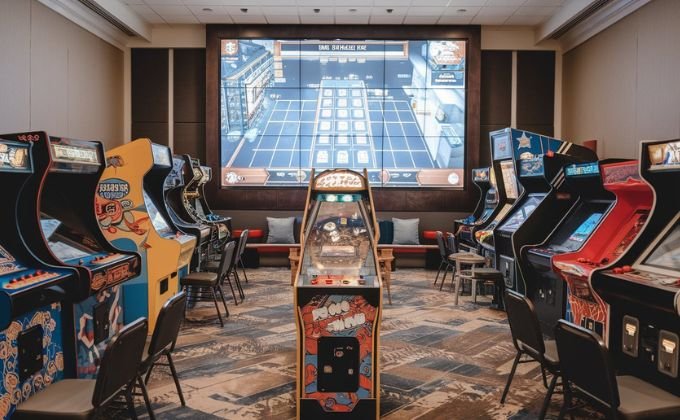Building a retro gaming collection is a rewarding journey that allows you to relive the nostalgia of classic games while preserving a piece of gaming history. Whether you’re a longtime gamer or just starting, creating a retro game collection can be both exciting and overwhelming. This guide offers essential tips for beginners looking to embark on this nostalgic adventure.
1. Define Your Focus
Before diving into collecting, it’s essential to define what types of retro games you want to focus on. Retro gaming can encompass a wide range of systems and genres, so consider these questions:
- Which consoles do you have a personal connection with? Think back to your childhood or any systems you grew up playing.
- What genres do you enjoy? Do you prefer action, RPGs, platformers, or something else?
- Are you interested in complete collections or specific titles? Some collectors aim for full sets, while others focus on acquiring their favorite games.
Defining your focus will help narrow down your search and make your collecting journey more enjoyable.
2. Research the Market
Knowledge is power when it comes to building a retro gaming collection. Take the time to research the market to understand pricing, availability, and the best places to buy games. Here are a few tips:
- Join Online Communities: Websites like Reddit, forums, and dedicated retro gaming communities can provide valuable insights into current trends and prices.
- Use Price Guide Websites: Websites such as PriceCharting and Game Value Now offer up-to-date price information on a wide range of games and consoles, helping you make informed purchasing decisions.
- Follow Collecting Blogs and YouTube Channels: Many collectors share their experiences, tips, and tricks online. Engaging with these resources can provide inspiration and guidance.
3. Start Small
When starting your retro gaming collection, it’s wise to begin small. Focus on a few titles or a single console before expanding your collection. Here are some tips for starting small:
- Buy What You Love: Instead of trying to collect everything at once, focus on games that you genuinely enjoy or that hold personal significance.
- Look for Bargains: Check local thrift stores, garage sales, and online marketplaces for deals. You might find hidden gems at a fraction of the market price.
- Prioritize Quality Over Quantity: It’s better to have a smaller collection of quality games than a large collection of incomplete or poorly maintained titles.
4. Know the Condition Grading System
Understanding how games and consoles are graded in terms of condition is crucial for making informed purchases. Here are some common grading terms you should be familiar with:
- CIB (Complete In Box): This term means the game comes with its original box, manual, and any other included materials.
- Loose: A loose game refers to a cartridge or disc without its original packaging or manual.
- Mint: A term used for items in perfect condition, with no visible flaws or wear.
- Good/Fair: These grades indicate varying degrees of wear or damage.
Knowing these terms will help you assess the value of items you encounter while collecting.
5. Create a Budget
Collecting play retro games can quickly become expensive, so establishing a budget is essential. Consider these tips for effective budgeting:
- Set Limits: Determine how much you’re willing to spend monthly or yearly on your collection to avoid overspending.
- Prioritize Purchases: Identify high-priority items and allocate your budget accordingly. Consider saving for more expensive titles rather than buying many cheaper ones.
- Track Your Spending: Keep a record of your purchases to help you stay within your budget and identify areas for improvement.
6. Explore Different Sources
There are many places to find retro games, and exploring various sources can yield fantastic finds. Here are some popular options:
- Local Game Stores: Many local game shops specialize in retro games. Building a rapport with store owners can lead to insider knowledge about upcoming sales or rare finds.
- Online Marketplaces: Websites like eBay, Mercari, and Craigslist offer a wide selection of retro games. Just be cautious and research sellers to ensure quality.
- Swap Meets and Conventions: Attending gaming conventions or local swap meets can expose you to a treasure trove of retro gaming items and a chance to meet fellow collectors.
7. Protect and Preserve Your Collection
Once you’ve started building your collection, it’s essential to take care of your games and consoles. Proper preservation can help maintain their value and ensure they last for years to come. Here are some preservation tips:
- Store Games Properly: Keep games in a cool, dry place, away from direct sunlight. Use protective cases for cartridges and discs to prevent scratches and damage.
- Clean Your Games and Consoles: Regularly clean your cartridges and consoles to ensure optimal performance. Use isopropyl alcohol and cotton swabs to clean cartridge contacts gently.
- Maintain Documentation: If you have manuals, boxes, or promotional materials, store them safely. CIB items tend to hold more value among collectors.
8. Enjoy the Process
Building a retro gaming collection should be an enjoyable experience, not a stressful one. Take your time, explore different avenues, and connect with fellow enthusiasts. Enjoy the thrill of the hunt and the joy of rediscovering classic titles that shaped the gaming landscape.
Conclusion
Creating a retro gaming collection is an exciting journey that combines nostalgia, passion, and the thrill of discovery. By defining your focus, researching the market, starting small, and protecting your collection, you can build a rewarding assortment of classic games. Embrace the adventure, and you’ll find that collecting retro games is not just about the games themselves but also about the memories and experiences they bring. Happy collecting!


